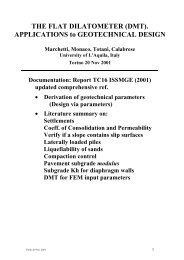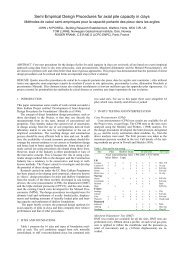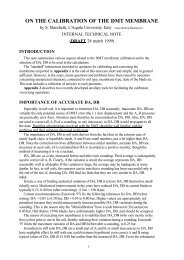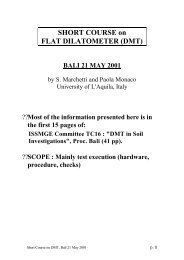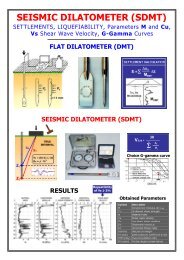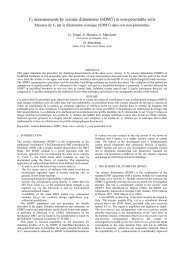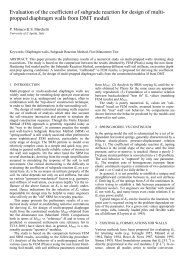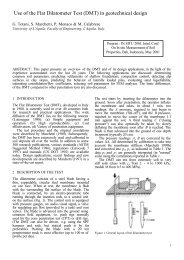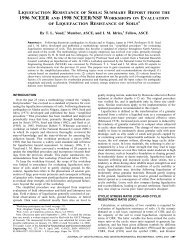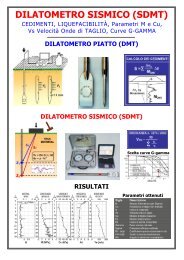The Flat Dilatometer Test (DMT) in Soil Investigations - Marchetti DMT
The Flat Dilatometer Test (DMT) in Soil Investigations - Marchetti DMT
The Flat Dilatometer Test (DMT) in Soil Investigations - Marchetti DMT
Create successful ePaper yourself
Turn your PDF publications into a flip-book with our unique Google optimized e-Paper software.
NOTE: Possible problems with light rigs<br />
Possible problems with light rigs (such as many SPT<br />
rigs) are:<br />
– Light rigs have typically a push<strong>in</strong>g capacity of only<br />
2 tons, hence refusal is found very soon (often at<br />
1-2 m depth).<br />
– Often there is no collar near ground surface (i.e. no<br />
ground surface side-guidance of the rods).<br />
– <strong>The</strong>re is a h<strong>in</strong>ge-type connection <strong>in</strong> the rods just<br />
below the push<strong>in</strong>g head, which permits excessive<br />
freedom and oscillations of the rods <strong>in</strong>side the hole.<br />
– <strong>The</strong> distance between the push<strong>in</strong>g head of the rig<br />
and the bottom of the hole is several meters, hence<br />
the free/buckl<strong>in</strong>g length of the rods is high. In some<br />
cases the loaded rods have been observed to<br />
assume a "Z" shape.<br />
– Oscillations of the rods may cause wrong results.<br />
In case of short penetration <strong>in</strong> hard layers it was<br />
occasionally observed that the "Z" shape of the<br />
rods suddenly reverted to the opposite side. This is<br />
one of the few cases <strong>in</strong> which the <strong>DMT</strong> read<strong>in</strong>gs<br />
may be <strong>in</strong>strumentally <strong>in</strong>correct: oscillations of the<br />
rods cause tilt<strong>in</strong>g of the blade, and the membrane is<br />
moved without control close to/far from the soil.<br />
NOTE: Push<strong>in</strong>g vs driv<strong>in</strong>g<br />
Various researchers (US DOT 1992, Schmertmann<br />
1988) have observed that "hammer-driv<strong>in</strong>g alters the<br />
<strong>DMT</strong> results and decreases the accuracy of<br />
correlations", i.e. the <strong>in</strong>sertion method does affect the<br />
test results, and static penetration should be<br />
preferred.<br />
Accord<strong>in</strong>g to ASTM (1986), <strong>in</strong> soils sensitive to<br />
impact and vibrations, such as very loose sand or<br />
very sensitive clays, dynamic <strong>in</strong>sertion methods can<br />
significantly change the test results compared to<br />
those obta<strong>in</strong>ed us<strong>in</strong>g a static push. In general,<br />
structurally sensitive soils will appear conservatively<br />
more compressible when tested us<strong>in</strong>g dynamic<br />
<strong>in</strong>sertion methods. In such cases the eng<strong>in</strong>eer may<br />
need to check such dynamic effects and, possibly,<br />
calibrate and adjust test <strong>in</strong>terpretation accord<strong>in</strong>gly.<br />
US DOT (1992) recommends that, if the driv<strong>in</strong>g<br />
technique is used, as a m<strong>in</strong>imum 2 sound<strong>in</strong>gs be<br />
performed side by side, one by push<strong>in</strong>g and one by<br />
driv<strong>in</strong>g. This would give a site/soil specific<br />
correlation, which would allow to get back to the<br />
parameters obta<strong>in</strong>ed from correlations based on the<br />
push<strong>in</strong>g <strong>in</strong>sertion (with added imprecision, however).<br />
Accord<strong>in</strong>g to Eurocode 7 (1997), driv<strong>in</strong>g should be<br />
avoided except when advanc<strong>in</strong>g the blade through<br />
stiff or strongly cemented layers which cannot be<br />
penetrated by static push.<br />
3.2 PUSH RODS<br />
While <strong>in</strong> pr<strong>in</strong>ciple any k<strong>in</strong>d of rod can be used, most<br />
commonly CPT rods or drill rig rods are employed.<br />
A friction reducer is sometimes used. However the<br />
consequent reduction <strong>in</strong> rod friction is moderate,<br />
because of the multi-lobate shape of the cavity<br />
produced <strong>in</strong> the penetrated soil by the blade-rod<br />
system.<br />
If used, the friction reducer should be located at<br />
least 200 mm above the center of the membrane<br />
(Eurocode 7 1997).<br />
NOTE: Use of stronger rods<br />
Many heavy penetrometer trucks perform<strong>in</strong>g <strong>DMT</strong><br />
are today also equipped with rods much stronger than<br />
the common 36 mm CPT rods. Such stronger rods<br />
are typically 44 to 50 mm <strong>in</strong> diameter, 1 m length,<br />
same steel as CPT rods (yield strength > 1000 MPa).<br />
A very suitable and convenient type of rod is the<br />
commercially available 44 mm rod used for push<strong>in</strong>g<br />
15 cm 2 cones.<br />
<strong>The</strong> stronger rods have been <strong>in</strong>troduced s<strong>in</strong>ce the<br />
rods are "the weakest element <strong>in</strong> the cha<strong>in</strong>" when<br />
work<strong>in</strong>g with heavy trucks and the current high<br />
strength <strong>DMT</strong> blades, able to withstand a work<strong>in</strong>g<br />
load of approximately 250 kN.<br />
<strong>The</strong> stronger rods have several advantages:<br />
– Capability of penetrat<strong>in</strong>g through cemented<br />
layers/obstacles.<br />
– Better lateral stability aga<strong>in</strong>st buckl<strong>in</strong>g <strong>in</strong> the first<br />
few meters <strong>in</strong> soft soils or when the rods are<br />
pushed <strong>in</strong>side an empty borehole.<br />
– Possibility of us<strong>in</strong>g completely the push capacity of<br />
the truck.<br />
– Reduced risk of deviation from the verticality <strong>in</strong><br />
deep tests.<br />
– Drastically reduced risk of loos<strong>in</strong>g the rods.<br />
Obvious drawbacks are the <strong>in</strong>itial cost and the<br />
heavier weight. Also, their use may not be convenient<br />
<strong>in</strong> OC clay sites because of the <strong>in</strong>creased sk<strong>in</strong> friction.<br />
3.3 ROD ADAPTORS<br />
<strong>The</strong> <strong>DMT</strong> blade is connected to the push rods by a<br />
lower adaptor (Fig. 8).<br />
<strong>The</strong> most common adaptor has its top connectable<br />
to CPT rods, its bottom connectable to the <strong>DMT</strong><br />
blade (end<strong>in</strong>g cyl<strong>in</strong>drical male M27x3mm).<br />
If rods other than CPT rods are used, specific<br />
adaptors need to be prepared (see Fig. 8).<br />
An upper slotted adaptor is also needed to allow<br />
lateral exit of cable, otherwise p<strong>in</strong>ched by the push<strong>in</strong>g<br />
head.<br />
7



